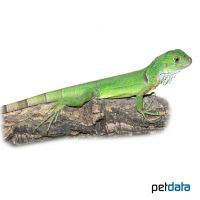Common Green Iguana (Iguana iguana)
| Common Green Iguana Iguana iguana | |
|---|---|
| Name | Common Green Iguana |
| Name Lat. | Iguana iguana |
| Family | Iguanas |
| Family lat. | Iguanidae |
| Order | Scaled Reptiles |
| Order lat. | Squamata |
| Origin | Central and South America |
| Habitat | Tropical forests |
| Diet | Veggies, fruits |
| Humidity | 60-80 % / 85-95 % |
| Behavior | Arboreal, ♂ territorial |
| Keeping | Pair, harem |
| Care Level | Difficult |
| Reproduction | Oviparous |
| Housing | Humid terrarium |
| Life Span | 15-20 years |
| Protection | CITES Appendix II; EU Annex B |
| Metric Units | |
| Size | 120-150 cm |
| Temperature | 25-30 °C |
| Temperature Local | 35-40 °C |
| Housing Size | 250 x 150 x 200 cm |
| US Units | |
| Size | 47"-59" |
| Temperature | 77-86 °F |
| Temperature Local | 95-104 °F |
| Housing Size | 100" x 60" x 80" |
Distribution and habitat
The diurnal green iguanas are widespread in the warm and humid lowlands of Mexico, Central America and Brazil. Mostly they live in loose groups in treetops above waters. As cultural successors they can also be found in settlements.
Maintenance
Minimum dimensions for the terrarium, according to the size and number of animals
| 1-2 animals | 5KRL x 3KRL x 4KRL or 4KRL x 3KRL x 5KRL (L x W x H) |
Head-torso length (KRL) is measured on the largest animal. For each additional animal, increase the footprint by 15%. A terrarium of L 250 x W 150 x H 200 cm is recommended, which should be placed in a quiet and vibration-free place
They need a spacious terrarium structured with strong, firmly mounted climbing branches and horizontal resting places with a substrate of leaf-soil-peat mixture, which must always be kept slightly moist. Artificial or resistant plants (e.g. dracaena, bromeliads, ficus) serve as decoration. A heated (approx. 25 °C), easy-to-clean water basin for bathing, with a water depth of 30-40 cm, is absolutely necessary. At night the humidity should be increased to 85-95%. A fogging or rain system is recommended
| Temp. day: 25-30 °C | Temp. night: 20-25 °C | Temp. local: 35-40 °C | Humidity: 60-80 |
The lighting duration must be 12-14 hrs. Light sources that also produce the necessary heat are ideal. In addition, daily UV irradiation is essential.
Diet
The main diet for adults consists almost exclusively of plant foods, such as wild herbs, leaves, alfalfa, tomatoes, leaf lettuce, Brussels sprouts, zucchini, cucumbers, carrots, peppers, squash, and fruit (pear, banana, melon, etc.), as well as sprouts and shoots. Alternatively, commercial food for herbivorous reptiles can be offered. Juveniles like to eat insects (crickets, grasshoppers, crickets) in the terrarium, but these should only be fed in very small quantities. It is important to add minerals and vitamins regularly (e.g. by dusting the food). Drinking water must always be available
A regular and varied diet promotes health and prevents deficiency symptoms.
Reproduction and breeding
A sure distinguishing feature of the sexes are the femoral pores, which are much smaller in females. During the mating season, males are also easily recognized by their hemipenis pockets. The female buries her eggs (10-60 eggs) in the substrate. The incubation period is 70-110 days at a temperature of 27-30 °C. Dandelion leaves, chickweed, etc., and small insects such as fruit flies and micro-unicates are suitable as initial food for the young
Species protection
They are exempt from the obligation to notify (Federal Species Protection Ordinance Annex 5 to § 7 para. 2).
Species protection: WA Appendix II; EU Appendix B. The proof of purchase is the required proof of origin for the animal. Please keep it safe! Your pet store will be happy to provide you with further information.
Important
They are good climbers, jumpers, swimmers and divers. Their tail, armed with spiny scales, is used for defense. Acclimated animals quickly become tame to feeding, but care should be taken with tail swipes. Adult males are territorial and incompatible with each other
They need 35-40 °C warm sunny places (e.g. climbing branches). For hibernation, shorten the lighting duration by 2-3 hours and lower the temperature by 3-4 °C for about two months.
The terrarium must have good ventilation without drafts and meet the species-specific needs. Measuring devices such as thermometers, hygrometers, etc. are necessary. The lighting has to correspond to the species-specific day-night rhythm and has to be placed in such a way that the animals cannot injure themselves. The terrarium should be locked in such a way that neither unauthorized persons can open it nor the animals can escape. Contamination must be removed regularly.
Further literature can be found in your pet store.
References
Text: petdata; Image: petdata
Source: BMELV (1997): Tierschutzgutachten - Mindestanforderungen an die Haltung von Reptilien; ENGELMANN (2006): Zootierhaltung - Tiere in menschlicher Obhut: Reptilien und Amphibien, Harri Deutsch Verlag
- Gemäß § 21 Abs. 5 Tierschutzgesetz idgF
